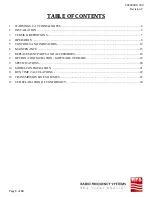
602400011500
Revision C
Page
7
of
24
3
TERMS
&
DEFINITIONS
3.1
Relative
Humidity
(RH)
is the moisture
content of the air relative to the maximum
possible moisture content at the current
air temperature. RH is measured in
percent (%). 100% RH represents
saturation, and is the point at which
condensation occurs.
Since RH is relative to temperature, the
RH of the air in the waveguide or cable
will fluxuate with the changes in air
temperature. As the air temperature
increases, RH will fall; as the air
temperature decreases, the RH will rise.
The air’s actual moisture content remains
constant.
3.2
Dew
Point
Temperature
(Td)
is the
temperature at or below the current
temperature at which the air would be
saturated with moisture (100% RH). Td is
measured in the same unit as ambient
temperature, typically Fahrenheit or
Celsius.
Dew point temperature is not affected by
air temperature fluxuations. Instead, it is
directly linked to the actual moisture
content in the air. For that reason, dew
point temperature is the measurement
most applicable to dehumidification
processes.
Dew point temperature is fairly constant
over time. Weather systems and seasonal
changes are the primary cause of dew
point temperature fluxuation over time.
When dew point temperature and
ambient air temperature are equal, then
the air is saturated (100% RH), and
condensation can form. Therefore, it is
important to keep the dew point
temperature of the air inside the
waveguide or cable below the ambient
temperature outside the waveguide or
cable to avoid condensation.
3.3
Dew
Point
Reduction
(Tdr)
is the
reduction of the dew point temperature
that results from the dehumidification
process. The larger the Tdr, the more
efficient the dehumidification process is.
3.4
Distribution
System
is the system of air
tubes, distribution manifolds, valves, and
RF lines to be pressurized with dry air
from the dehydrator’s output fitting.
3.5
Active
dehydrator operation is when the
unit’s compressor is on and pressurized
dry air is being supplied from the unit’s
output fitting.
3.6
Run
Time
is the time that the unit spends
in active operation to pressurize the
distribution system.
3.7
Standby
dehydrator operation is when
the unit is energized but the compressor is
not on. The distribution system pressure
is in the unit’s configured operational
range, and is being monitored by the unit’s
control board. This is the predominant
operational condition.
3.8
Duty
Cycle
is the time in active operation
vs. standby operation, measured in
percent.
% =
100
3.9
Lower
Operational
Pressure
(LOP)
is
the configured pressure at which the
dehydrator will switch from standby to
active operation to re-pressurize the
system.
3.10
Upper
Operational
Pressure
(UOP)
is
the configured pressure in psig at which
the dehydrator will switch from active to
standby operation. This is also the system
pressure, or the maximum pressure
desired in the distribution system.








































